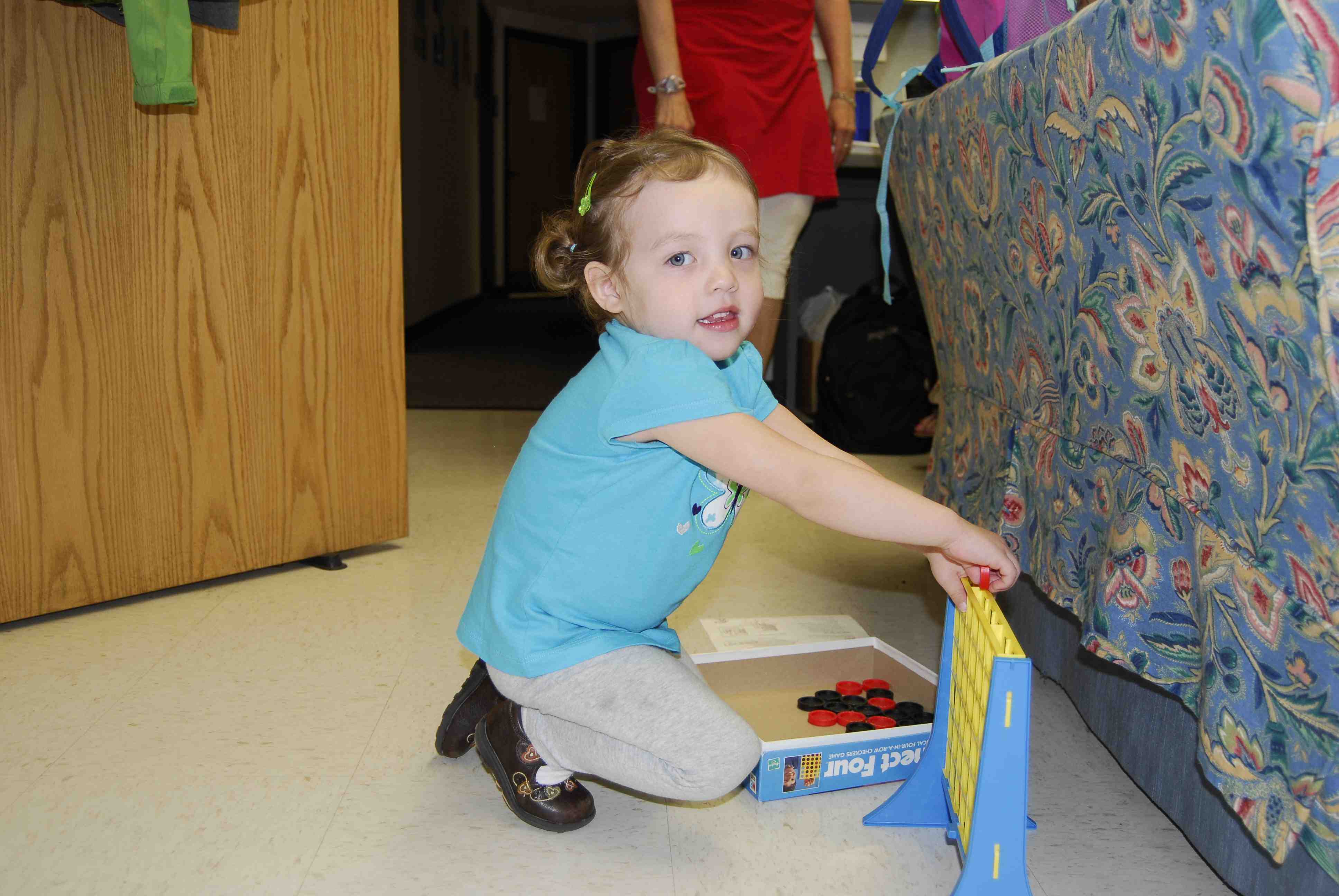George Mason University
Child Development Lab
Department of Psychology


Social-emotional Measures
Affective Knowledge Test
- Bassett, H. H., Denham, S. A., Mincic, M. M., &
Graling, K. (2012). The structure of preschoolers' emotion
knowledge: Model equivalence and validity using an SEM
approach. Early Education
and Development, 23, 259-279. doi:
10.1080/10409289.2012.630825
- Denham, S. A., Bassett, H. H., Way, E., Mincic, M., Zinsser, K., & Graling, K. (2012). Preschoolers’ emotion knowledge: Self-regulatory foundations, and predictions of early school success. Cognition and Emotion, 26, 667-679. doi: 10.1080/02699931.2011.602049
- Denham, S. A. (1986). Social cognition, prosocial behavior, and emotion in preschoolers: Contextual validation. Child Development, 57, 194-201. doi: 10.2307/1130651
Assessment Summary
The Affect Knowledge Test (AKT) measures preschool children's receptive and expressive knowledge of emotion through identification of happy, sad, angry, and afraid puppet faces. Children's situational knowledge of emotion is also assessed by their identification of how puppets feel during a series of puppet vignettes. During these vignettes, puppeteers pretend, through vocal, facial, and bodily expression, developmentally appropriate, emotionally laden situations.
Versions
Long Parent English
Long Parent Japanese
Long Parent Portuguese
Long Parent Italian
Short Parent English
Short Parent Spanish
Short Teacher English
Computerized Short Teacher English
Manual Request
Example
Relevant Citations
Challenging Situations Task
- Denham, S. A., Kalb, S. C., Way, E., Warren-Khot, H. K., Rhoades, B. L, & Bassett, H. H. (in press). Social and emotional information processing in preschoolers: Indicator of early school success? Early Child Development and Care. doi: 10.1080/03004430.2012.682728
- Denham, S. A., Way, E., Kalb, S. C., Warren-Khot, H. K.,
& Bassett, H. H. (2013). Preschoolers' social information
processing and school readiness: The Challenging Situations
Task. British Journal of
Developmental Psychology, 31, 180-197 doi:
10.1111/j.2044-835X.2012.02085.x
- Denham, S. A., Bouril, B., & Belouad, F. (1994). Preschoolers' understanding of challenging peer situations. Child Study Journal, 24, 1-21.
Assessment Summary
The Challenging Situations Task measures preschool children’s social-emotional information during developmentally appropriate peer situation vignettes through selection of affective and behavioral responses. Children are presented with a series of cartoon vignettes where a child is confronted by an aggressor. After the situation is presented, children are asked, “How would you feel?” with Happy, Sad, Angry, or Just Okay cartoon faces as options. Then, children are asked, “What would you do?” and are presented with situational options that include prosocial, aggressive, manipulative, and avoidant options.
Versions
English (CST-R)
Spanish (CST-R)
Manual Request
Example
Relevant Citations
Parent and Child Forgiveness Inventories
- Shewark, E.(2012, Spring). Learning forgiveness: The influence of interparental conflict on child forgiveness. M.A. Thesis.
- Watanabe, N. (2011, Spring). Forgiveness in Japanese children and adolescents: Dispositional, emotional, and parental influence. M.A. Thesis.
- Bassett, H. H. (2007, Spring). Individual differences in children’s forgiveness: Intraindividual, parental, and family environmental contributors. Ph.D. Dissertation.
- Neal, K. L. (2005, Fall). The relationship between children’s propensity to forgive, parents’ propensity to forgive and parenting practices.Ph.D. Dissertation.
Assessment Summary
Coming soon!
Versions
Child English (CFI)
Child Japanese (CFI)
Parent English (PFI)
Manual Request
Example
Coming soon!
Relevant Citations
Minnesota Preschool Affect Checklist
- Revised/Shortened
- Computerized Revised/Shortened
- Denham, S. A., Bassett, H. H., Thayer, S. K., Mincic, M., Sirotkin, Y.S, & Zinsser, K. (2012). Observing preschoolers’ social-emotional behavior: Structure, foundations, and prediction of early school success. Journal of Genetic Psychology, 173, 246-278. doi: 10.1080/00221325.2011.597457
Assessment Summary
The Minnesota Preschool Affect Checklist is an observational measure of preschool children’s social-emotional functioning. Observers note for the presence of relevant behaviors for four, 5-minute coding intervals in a variety of naturalistic settings where children are playing and interacting with others. Coding intervals are spread out over a period of weeks. Behavioral items are collapsed into 9 categories, like positive and negative affect, positive and negative engagement, positive or negative reactions to frustration, peer skills, empathy, and unusual behavior.
Versions
Manual Request
Relevant Citations
Focal: Focal-Target Observations of Emotions and Reactions to Emotions
- Legacy Parent
- Legacy Peer
- Peer
- Teacher
- Denham, S. A., & Bassett, H. H. (2013) Focal-t: Focal Observations of Teachers’ Emotions and Reactions to Children’s Emotions. George Mason University, Fairfax VA.
Assessment Summary
The focal coding system of emotions and reactions to emotions utilizes focal-target, mutually exclusive and exhaustive observational coding for use in naturalistic contexts. For the first 5-minute coding trial, observers note for the presence of emotion codes, watching the focal individual’s facial, vocal, and behavioral expressions of emotion. When an emotion is coded, the target individual(s)’ reactions to this emotion, via facial, vocal, and/or behavioral means, are immediately coded. If the focal individual has ceased emoting by the end of target reaction coding, the observer codes the focal individual as neutral, and continues to watch for additional focal emotion coding opportunities. Upon completion of the first trial, observers switch focal and target individuals and complete another 5-minute coding trial, altogether constituting a 10-minute session; 8 sessions are completed in total. Focal-target mutually exclusive and exhaustive coding produces data streams that fit the necessary conditions for advanced analyses, including lag sequential analyses. Our laboratory is currently using tablet computers and an observational software package developed and maintained by Dr. William Roberts that facilitates the coding and analyses of focal-target data. Both a peer-child and teacher-child version is used by our lab in preschool classrooms (Focal-t), and legacy parent-child and peer-child versions have been used in the past (Focal-parent/peer).
Versions
Manual Request
Coding Program
Observational Programs developed by Dr. William Roberts.
Relevant Citations
Emotion Elicitation and Regulation Assessment
Assessment Summary
Coming soon!
Manual Request
Coming soon!
Example
Coming soon!
Relevant Citations
Coming soon!
Parent-Child Affect Communication Task
Assessment Summary
The Parent-Child Affect Communication Task (PACT) is a coding scheme used for the analysis of parent-child emotional discourse (e.g., emotional reminiscence task, picture book reading). In this coding scheme, a trained coder identifies emotion terms, a reference of the emotion (e.g., own emotion, target’s emotion), and a functional attribution of the emotion (e.g., explaining, questioning, socializing). The total number of emotion terms, reference, and function is calculated for each speaker separately. The PACT coding has been used to tap “teaching/coaching” aspect of parental socialization of emotion. In addition to dyadic conversation, this coding scheme can be used with a group setting, such as book reading time at preschool to observe how preschool teachers talk about emotion in classroom.
Manual Request
Relevant Citations
Denham, S. A., Mitchell-Copeland, Strandberg, K., Auerbach, S., & Blair, K. (1997). Parental contributions to preschoolers' emotional competence: Direct and indirect effects. Motivation and Emotion, 27, 65-86. doi: 10.1023/A:1024426431247